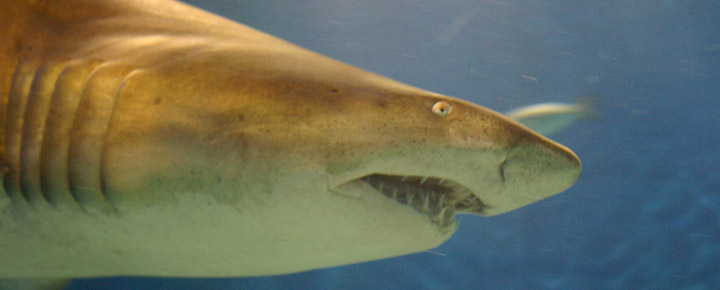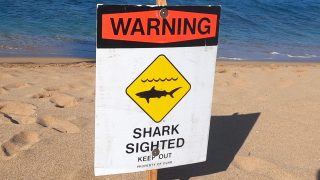This shark update came across our desks as we prepare to participate in the Hanalei Bay Swim Challenge on Saturday. After all, Hanalei is nearby Beat of Hawaii headquarters and where we’ve personally seen sharks in the water, although we’ve never had any problems. Today’s update gave us food for thought about those experiences and even what we might wear in the ocean.
For years we’ve read that sharks have poor eyesight, which could be one reason they mistake humans for their food resulting in a shark bite. But recent research indicates otherwise. We are now learning that sharks may see far more and better than we previously knew.


Ocean rescue equipment is bright by intention. But could bright colors also attract shark attacks?
Yellow and orange are seen easily in contrast to the dark blue ocean. And those colors can help save someone seen from a ship, helicopter, or aircraft. But could bright colors also attract sharks in an unwanted way?
During the sinking of the USS Indianapolis in World War II, the color of the life preservers that those onboard wore may have played a role in their unprovoked attacks. And the idea that bright-colored bathing attire and ocean equipment may not be the best plan comes into focus.
“Yum-yum yellow” | Is that sharks’ favorite color?
The notion that brightly colored life-saving devices attracted predators has led to the coining of the term yum-yum yellow. That idea about bright colors possibly attracting sharks has a long history, but now there’s more corroborating information than before that both residents and visitors might heed.
A U.S. Navy video done by shark scientists addresses the vision of sharks. Shark scientist Sam Gruber said that in sea disasters, Navy pilots who wore orange suits were attacked by sharks, while crew members wearing green khaki were not attacked. Samuel Gruber (May 13, 1938 – April 18, 2019) is a renowned shark biologist who founded the American Elasmobranch Society. He was also a professor at the University of Miami’s Rosenstiel School for Marine and Atmospheric Science and founded the Bimini Biological Field Station Foundation.
.”
Does the attractiveness of colors vary by species of shark?
The U.S. Navy has long suspected an association between the color of ocean equipment and attire and some shark attacks.
Being highly adapted, Shark species have great and varying ability to discern colors under different circumstances and at other times of the day. Gruber, a renowned shark specialist, said sharks have excellent visual acuity. Their eyes vary by species, with some having different characteristics, including rod and cone vision, and thus high-quality detail and color discernment.
We had always heard that sharks’ vision was poor.
A prevailing thought was that with largely rod-only vision, sharks would have a dim and monochromatic view of the world. That may still, in fact, be true for some well-adapted deep-water sharks, where the environment requires less color and detail discernment and more motion detection. Gruber said, however, that the great white sharks were among those that have largely cone vision, which means more detail and color discernment.
White tip ocean sharks.
These sharks, also found in Hawaii are the ones most associated with attacks written about by Gruber, those that followed plane crashes and ship sinkings. The white tip sharks are believed to have less accurate rod vision with poor color awareness. These sharks aren’t to be confused with the white tip reef sharks, which are rarely seen as menacing.
Gruber, whose research occurred in the 70s, sought to determine which colors these sharks could distinguish. He believed that many shark species have a monochromatic vision, having lost color awareness during evolution. But that should not be read as not having good eyesight. Instead, the research indicates that even deep ocean sharks have good contrast vision. The notion that we had about all sharks is evolving.
In other research conducted in Australia. Biologists concluded that for some sharks, such as great whites, poor water visibility could lead to a lack of distinction between seals and humans in the water. Otherwise, they found that great whites have better color detection than many other species.
Sharks are attracted to patterns.
Researchers believe that both patterns, as well as color combinations, may be attractants to these amazingly well-adapted animals. Sharks may also be attracted to the contrast of colors beyond the colors themselves. Back to Gruber’s research from a half-century ago, some sharks were more sensitive to certain colors in the daytime than in the evening. That is further defined as the tendency for eye sensitivity to shift toward the blue at low illumination levels as part of the dark adaptation associated with sharks.


Should Hawaii tourists ditch bright-colored and patterned swim gear?
For sure, sharks have better vision than we’d grown up believing. And they have amazing eyes that are both retractable into their sockets and armored for protection. Japanese research indicates that whale sharks, for example, may see divers at up to 20 feet of distance. In addition, their eyes are similar to cats and use all available light to enhance vision which may be especially useful for hunting during hours of little light.
Some sharks may be attracted to things that others are repelled by. While some sharks may be repelled by attire similar to poisonous sea snakes, for example, other species that eat those sea snakes may be attracted instead.
About a decade ago, a company developed wetsuits for surfing (pictured above) designed to either 1) look like a sea snake or 2) feature blue and gray to help surfers fit in with their surroundings to help prevent unprovoked bites. While the latter might be great for avoiding great white attacks, the former has been designed for preventing Hawaii’s deadly tiger shark attacks. We haven’t heard that these either work or don’t, but they are still for sale ten years later.
International Shark Attack File’s recommendations on avoiding shark attacks.
Avoid being a food source for sharks on your Hawaii vacation! Depending on circumstances, world-renowned shark experts say, “the benefit of increasing one’s chances of being rescued far outweighs the minimal risk of attracting a shark.”
Alternatively, divers and swimmers can probably reduce the chance of an interaction with a shark by avoiding bright and highly contrasting swimwear or dive gear. We personally prefer to use dark blue or black fins, mask, tank, and wetsuit while diving.
International Shark Attack File
Skip the jewelry, too, and avoid shark attacks.
Some experts believe that the color of your bathing suit isn’t as crucial as avoiding shiny objects like watches. Those can reflect light much like fish scales would. According to the International Shark Attack File, swimmers, snorkelers, surfers, and divers should hide their watches to help avoid unprovoked shark bites.
Get Breaking Hawaii Travel News





Hi BOH editors – good wishes for a great swim!
Have you researched SharkBanz? A surfer developed it after his surfing buddy was attacked by a shark. More good research there too. You can wear it on your wrist or ankle.
Would love to learn if anyone reading this has used SharkBanz.
Mahalo!
Hi Mary.
Thanks twice – for the reminder about SharkBanz, and also for your best wishes. We haven’t tried those but would also be interested to hear from those who have.
Aloha.
This is an inaccurate heading. It should reference “Oceanic White Tip sharks”.
White tip reef sharks are not associated with many human attacks.
Very informative and interesting article. I was also taught to heed those “brown water” advisories. Murky water is no bueno.
I like the look of those swim suits. Very “eely”. Yummay yummay Moray.
I believe that you are mistaking the white tip reef shark for oceanic white tip. The oceanic white tips are quite aggressive and live off-shore. White tip reef sharks are non-aggressive in-shore sharks that hang out under ledges or in caves during the day. I’ve often dove with white tip reef sharks at Mala ramp and Makena landing. I’ve never seen any aggressive behavior.
It Is the Oceanic White Tip…….. Not a variety you ever want around, period. Period. They Are always aggressive with one thing in mind. They come in at various (progressively closing) angles and diminishing distance, sizing the situation up. Again…… They have one thing in mind………
BOH actually wrote the following:
The white tip sharks are believed to have less accurate rod vision with poor color awareness. These sharks aren’t to be confused with the white tip reef sharks, which are rarely seen as menacing.
I have read before that jewelry may attract sharks. I admire the ones who swim and surf in the ocean but for me the surest way to avoid sharks is I don’t go in the ocean.
Love the info! I’ll put in a good place.
Hi Roy.
Thanks. Good to hear from you.
Aloha.